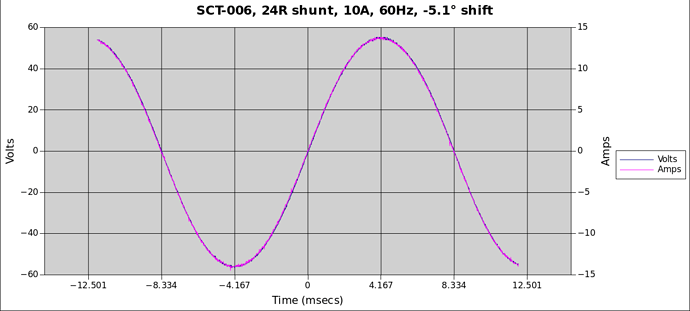Intrigued by some recent comments in this thread: SCT-006 on emonPi
I thought it might be worth taking a closer look at the SCT-006 driving a 24R burden. @Gwil kindly sent me one to test and it arrived earlier this week.
Equipment used: Time Electronics 5077 Power Calibrator
Agilent/Keysight DSO-X 3024A Scope
Ch1 (Yellow) is the voltage across the CT connected to a 1% 24R
Ch2 (Green) is the voltage output of the calibrator (set to 40V throughout)
Calibrator set to 10A, 60Hz, 40V, 0° phase shift gives this picture:
When you’ve got two perfect sine waves, measuring the phase shift is pretty simple and the scope clocked this one at 5.06°, so I “calibrated” that away with…
Calibrator set to 10A, 60Hz, 40V, -5.1° phase shift, which gives this picture:
scope_298.csv (87.4 KB)
(so nicely lined up it’s hard to believe there are two signals being displayed)
The four numbers in the Mean column are looking very good. Nominally they should be reading: 300mV, 40V, 0° and 60Hz. Without making any further changes to the phase adjustment (i.e. locked it at the -5.1° that worked for 10A) I doubled the current:
Calibrator set to 20A, 60Hz, 40V, -5.1° phase shift, which gives this picture:
scope_300.csv (87.4 KB)
There’s significant distortion in the current signal, and the voltage across the shunt (representing Irms) should nominally be 600mV but is only managing 574mV … the equivalent of 19.1A primary instead of the actual 20A. Ignore the Phase measurement (19.58°) as it’s meaningless once the signal distorts, although it does show just how kinked the Yellow signal is.
To really see how distorted the signal is we can look at the FFT of the Yellow channel:
There’s now a significant amount of current in all those odd harmonics and this from a “load” that’s purely resistive with a unity PF.
If you recall the definition of Real Power in the frequency domain, you can immediately see where this is headed:

where Vn and In are respectively the voltage and current rms values of the nth harmonics of the line frequency, and φn is the phase difference between the voltage and the current nth harmonics.
All those V’s except for the fundamental (n=1) will be 0, so all those I peaks at the odd harmonics are lost forever with regards contributing to Real Power. All that is a kinda’ complicated way of saying that the impact of that distortion on Real Power is likely to be even greater than it is on Irms (which is out by about 4.5%).
To test that, I extracted the raw data from the scope and did a simple single-cycle power meter with a spreadsheet. For current, I used the nominal calibration (i.e. voltage across the shunt * 20 / 0.6)
First I used the clean distortion free 10A data to test the “meter”. The first step of that is to plot the data to make sure it’s a good match with what was on the screen:
(use scope_298.csv above to recreate this).
Once again, so clean it’s hard to see the two signals.
The spreasheet single cycle power meter calculated that at:
Vrms: 39.87V (0.3% below nominal)
Irms: 9.94A (0.6% below nominal)
RealPower: 396.2W (1.0% below nominal)
PF: 0.9999
Then I took the distorted data:
(use scope_300.csv above to recreate this).
That one calculated as:
Vrms: 39.87V (0.3% below nominal)
Irms: 19.14A (4.3% below nominal)
RealPower: 749.8W (6.3% below nominal)
PF: 0.9823
As Robert predicted in the thread referenced above, the data at 50Hz is quite a bit worse. I’ll post that in a follow up reply.
[EDIT] Raw scope .csv files added.












 ). What I do think though, is that this should go into the ‘Learn’ part of the website.
). What I do think though, is that this should go into the ‘Learn’ part of the website.







